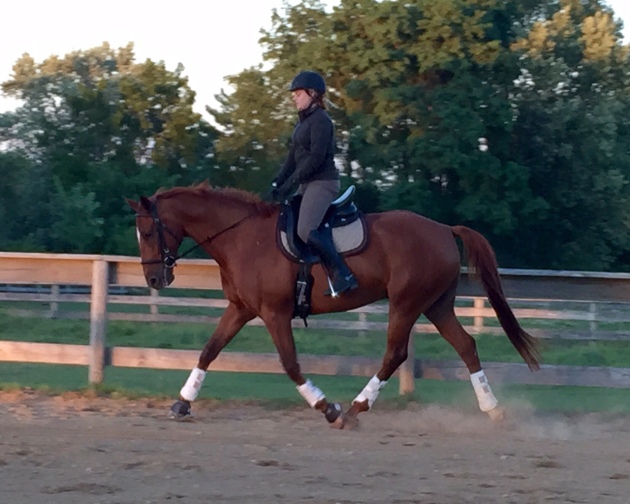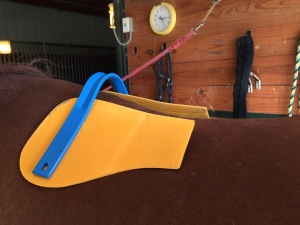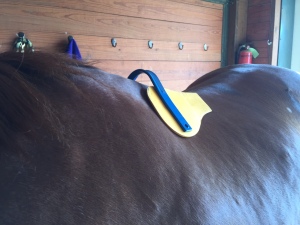Revving Up vs Ratcheting Back
August 24, 2015 2 Comments

Going for a spin with Christy. She is swimming in my saddle, which we determined to be out of balance during this session. Fred looks pretty though!
There’s no question that dressage requires a forward-thinking horse. You can’t achieve diddly unless the horse is up in the bridle, working over his back and those hind legs are connected.
But how you arrive at that magical point of connectedness can vary. You can either harness and guide the energy of a self-propelled, forward horse, or you can try to generate it from a less motivated creature.
The majority of riders will pick option one, the self-propelled horse. In purchasing Fred, I picked option 2. The horse I will enjoy riding most is the one I am not worried will flee to the next county at the slightest provocation.
 All that said, Fred’s sellers disclosed that one of his go-to evasions was stopping or, as I would call it, balking. And I ran into this last week when Fred decided that simply walking forward was too much to ask.
All that said, Fred’s sellers disclosed that one of his go-to evasions was stopping or, as I would call it, balking. And I ran into this last week when Fred decided that simply walking forward was too much to ask.
The online message boards are full of “What do I do when my horse won’t go forward” threads, and balking is a common evasion. It’s also one that you don’t mess with, because it can be a precursor to rearing, and that is flat out dangerous. Maddie balked with me at one point, and Christy made it clear in that moment that I had to deal with the behavior clearly and unequivocally. The next instant I felt her suck back and get light on her front end, I reached back and gave her an almighty crack with the whip, and … the mare said “Okay, fine.” and went forward.
Maddie was kind of terrifying to me, Fred isn’t. However, I do know that my saddle isn’t 100% comfortable for him, so I want to be fair to him as well. That said, his back isn’t sore, and he can walk forward. And I need him to move to gauge the adjustments I make. Without an honest response from him, I can’t determine whether or not the fixes I make help. I need Fred to meet me half way.
Back to the balking. I’m not going to beat a horse that I know to be uncomfortable through long rides, but a “yes ma’am” response is non negotiable. I made a mental note to build in time for some ground work, and then set to immediate work on Mr. Balky, setting his inside hind leg into motion, by putting my heel (equipped with a baby spur) into his side – asking him to step step step step step – with his inside hind into the outside rein, effectively doing a tiny little circle. I also added to the negative pressure by tapping him firmly with the whip. Not beating, but keeping the pressure up while we did our little circle.
I was giving him a choice. He could either walk forward nicely and willingly on a long rein, or we could do what is the equine version of isometrics, working much harder on that tiny circle, with the incessant tapping whip.
He gave me the wrong answer when I gave him him the first opportunity to rethink his approach, so back into the little circle we went, and I turned up the volume with the whip, giving him a couple good swats before resuming the tap-tap-tap-tap. That did the trick – he decided that a nice marching walk, complete with a swinging back (see, I told you the saddle really isn’t that far out of whack) was not unreasonable.
However, when I asked him to trot, he balked again. Back onto the circle, with the higher volume whip (swat! tap tap tap.) The ride was ugly – I had to do five or six of the little circles before Fred finally did walk/trot transitions up and down from minimal aids, and then we had a few more skirmishes going the other direction. However, over the following days, the resistance faded, and I could finally get a better read on his comfort.
I decided that Fred is telling me that he’s happy to go forward but honest bend is an issue, and that the saddle might be sitting too low, interfering with his shoulders. Christy confirmed this, too – I’m having her hop on at regular intervals to get a second opinion on saddle fit, and she encountered resistance when she asked Fred for engaged and correct bend.
We agreed that trying a narrower gullet would be a good next step, and then I decided to add some shims to my saddle (4 millimeter in the front and middle) after playing with the gullet, shims and a very patient Fred yesterday.
I’ve said it before, and I am sure I will say it again, but Bates has created something wonderful with their adjustable saddles. They come apart and back together easily, and in minutes I had the shims installed, along with the narrower gullet. Now, it is worth noting that not every tree fits every horse. However, I was specifically looking for a horse with a wither when I was shopping – I wanted to avoid the hoop tree wearing crowd. Partially because I like the way a wither secures a saddle on the hores’s back – you don’t need to ride with a super tight girth. Additionally, I love my Isabell. If at all possible, I want to keep this saddle. Fred’s back shape reminds me a bit of Derby’s, and more of Christy’s horse Remy’s, though of course he’s broader than both, so I am hopeful.
After I had my saddle back together, I tacked Fred up. I didn’t use a half pad, and was satisfied with how things looked visually – the balance looked good, no pinches or gaps, all righty then, let’s try this!
It’s tough to say whether it was a function of my saddle fitting genuis luck, the cool weather or the fact that Fred was feeling fresh asfter two days off. It was probably a combination of the variables, but he felt great – fresh and frankly forward! He caught me by surprise, and it took me a minute to get my half halts working to regulate his spanking trot.
I believe I started to feel his back come up, too, and that is what I am really seeking – that, and getting Fred comfortable bending. Unfortunately, I didn’t have the time or energy after a long car trip earlier in the day to do a longer ride. We will revisit this again tonight in my lesson.
I think I am definitely on the right track with the narrower fit, but may need to add a little more to the front shims. I know from past experience that a few millimeters here and there can make a world of difference to the horse, and when you finally make he horse comfortable, so many “problems” you were having evaporate.
We’ll get there. Who knows, maybe ol’ Freddie has more forward gears than we knew.



I loved my Isabelle. Sadly, my mare outgrew it and we are now firmly in the hoop tree crowd. We also have to use a non-slip pad due to her lack of withers. I do miss my Isaeblle, the twist was for sure much nicer on my hips, but I guess that’s what I get for buying a super wide tank of a horse!
Hmm. Think I’ll give the little isometric circle a try… I’m too meek sometimes 😦